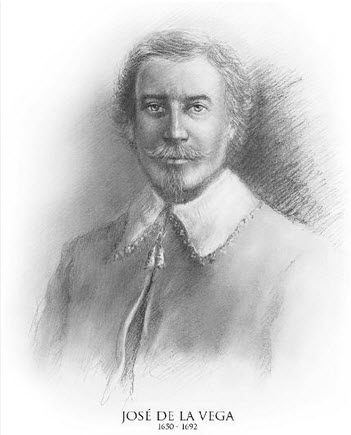The basics of technical analysis have been used for centuries, and various individuals in different parts of the world have contributed to the development of our modern-day tools and techniques. Here, we will look at a few of the early contributors.
Josseph de la Vega (ca. 1650 – 1692)
 The Amsterdam-based diamond merchant Josseph de la Vega wrote the first study of the Amsterdam Stock Exchange and its participants, the book “Confusión de Confusiones”. The volume, which was written in Spanish, was printed in Amsterdam where de la Vega lived and published in Antwerp where he had been born.
The Amsterdam-based diamond merchant Josseph de la Vega wrote the first study of the Amsterdam Stock Exchange and its participants, the book “Confusión de Confusiones”. The volume, which was written in Spanish, was printed in Amsterdam where de la Vega lived and published in Antwerp where he had been born.
Among other things, “Confusion de Confusiones” deals with concepts such as herd behaviour, overconfidence and regret aversion, and is credited for helping to lay the foundation for the modern fields of technical analysis and behavioural finance.
Honma Munehisa (1724-1803)
Honma Munehisa was a Japanese rice merchant who traded in the complex Dojima Rice Market in
Osaka. He developed a type of technical analysis which evolved into the use of candlestick patterns. He is known as the “God of Markets” and the “Father of the Candlestick Chart”.
The Dojima Rice Market is famous for being an early example of commodity derivatives, as rice
futures were in use there as early as the 1700s. The basis for the system was coupons that promised delivery of rice at a future time, and a secondary market developed for these coupons.
Allegedly, Honma created a network of communicator between Osaka and Sakta – a distance of
roughly 600 km – to be able to send and receive information about market prices.
In 1755, Homna wrote the book “San-en Kinsen Hiroku”, which is one of the first books on market
psychology. In this book, Honma highlights psychological aspects of trading, how traders´
emotions impact rice prices and how a trader that understands this can use it to take a position against
the market. Honma also describes the rotation of Yin and Yang markets (what we in English would call Bear and Bull markets) and claims that within each type is an instance of the other type.
Charles Dow (1851-1902)
Charles Dow was a United States journalist who co-founded both the Dow Jones & Company and The Wall Street Journal. He did extensive market movement research, invented the Dow Jones
Industrial Average and established a series of principles for understanding an analyzing market
behaviour. Today, this series of principles is known as Dow Theory, and it is an important part of the groundwork for modern technical analysis.
William Peter Hamilton (1867-1929)
William Peter Hamilton was the fourth editor of the Wall Street Journal and a strong proponent of Dow
Theory. He utilized Dow Theory in his efforts to learn how to predict future stock movements based on precise prior action, and in the early 1920s, he began referencing Dow Theory quite frequently in his
articles and editorials.
Robert D. Edwards and John Magee
In 1948, Robert D. Edwards and John Magee published the book that is now considered one of the
seminal works in the field of technical analysis: “Technical Analysis of Stock Trends”. With its focus
on trend analysis and chart patterns, it is still recommended reading for anyone interested in using
technical analysis. Back then, technical analysis was almost exclusively based on charting, as doing
statistical analysis using the immense processing power of our contemporary computers was not an
option.
This article was last updated on: January 30, 2023
